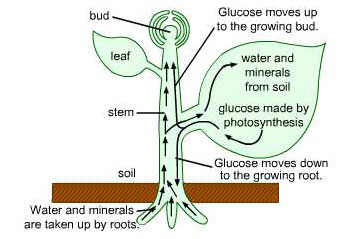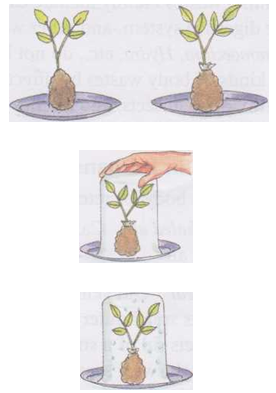Transport of Water and Minerals in Plants
Transportation In Plants
There are three different kinds of plants, i.e., herbs, shrubs, and trees. Plants need to transport water from the roots to the leaves. Then the food manufactured in the leaves is transported to different parts of the plant. Though the complexity may vary, the mode of transport in all the three types of plants is essentially the same.
Some materials (gases) pass in and out of plants through diffusion. Other materials required for building plant body are obtained from soil, e.g. , nitrogen, phosphorus, other minerals, water. They have to be transported to long distances depending upon the size of the plant. There are two independent pathways having conducting tubes. One is xylem that moves water and minerals from soil to aerial parts. The other is phloem which carries food from the region of availability (e.g, leaves, storage organs) to the areas of utilsation.

Xylem (Wood) :
A tissue called xylem acts as the pipeline, and takes water and minerals from the roots up the stem, and to the leaves. Absorption of water and minerals is a continuous process. Water is continuously being lost from the leaves by the process of transpiration (loss of water vapour from the stomata of leaves). This creates a low pressure and a pulling force results which pulls up the water and minerals. In this way, water and minerals are transported to different parts of the plant. This is similar to what happens when we drink juice or water through a straw.
It is a complex tissue which transports sap (water and minerals). Xylem has four types of cells–xylem fibres, xylem parenchyma, tracheids and vessels. Vessels and tracheids are called tracheary elements because they take part in transport of sap. Both the tracheary elements have lignified wall.
Phloem :
Food in plants is manufactured by the leaves. Once the food is prepared, it needs to be sent to all parts of the plant. The process by which this takes place is called translocation. Special types of tissues called phloem act as pipelines, and carry the prepared food to all parts of the plant.
It is complex tissue which takes apart in transport of food. Phloem has four types of cells – sieve tubes, companion cells, phloem parenchyma and phloem fibres. Only phloem fibres are dead cells. Other are living cells.
Activity
Aim: To demonstrate transpiration
Materials needed: A potted plant, a polythene bag, a glass jar, and a plate.
Method:
1. Place the potted plant on the plate, and enclose the soil of the pot in a polythene bag.

2. Now cover the plant with a glass jar.
3. Leave it undisturbed for some time.
Observation: You will notice tiny droplets of water on the inner surface of the glass cover.
Conclusion: The water comes mainly from the leaves, as the soil has been covered completely. This shows that plants give out water vapour during transpiration.
Aim: To prove that translocation of water takes place through the xylem Materials needed A twig, an empty jam jar, red/blue food colouring, and water
Method:
1. Fill the jam jar three-fourths with water.
2. Add a few drops of red/blue food colouring to the water.

3. Place the twig in this water.
4. Record observations over a period of five days.
Observation: Faint flecks of colour are observed on the leaves gradually over the period of five days. If a cross-section of the stem is cut, tubes coloured with red/blue can be seen towards the centre of the stem. This is where xylem is present. The leaves above the ring look fresh and green. The portion below the ring withers.
Conclusion: This shows that xylem transports water and minerals.
